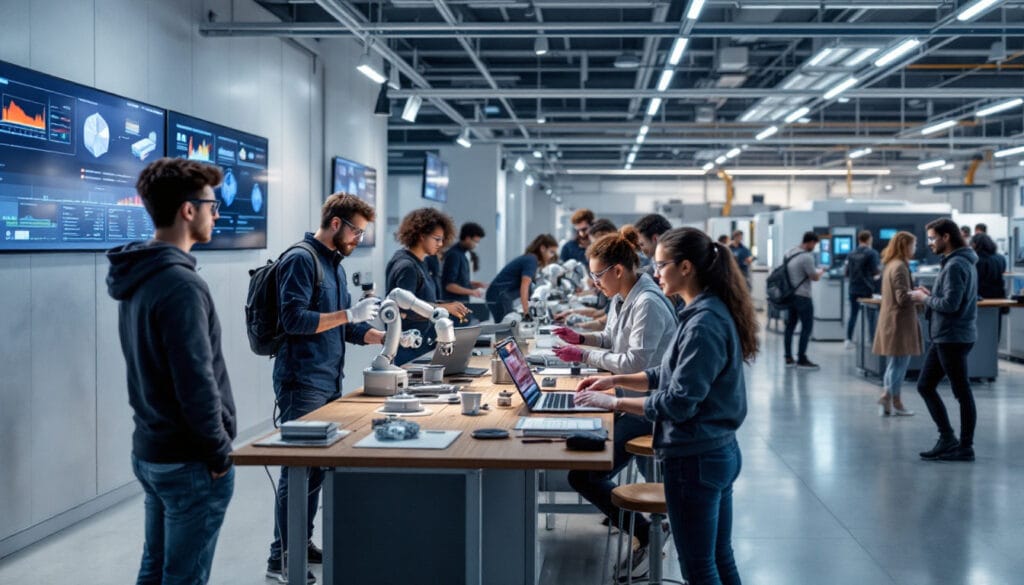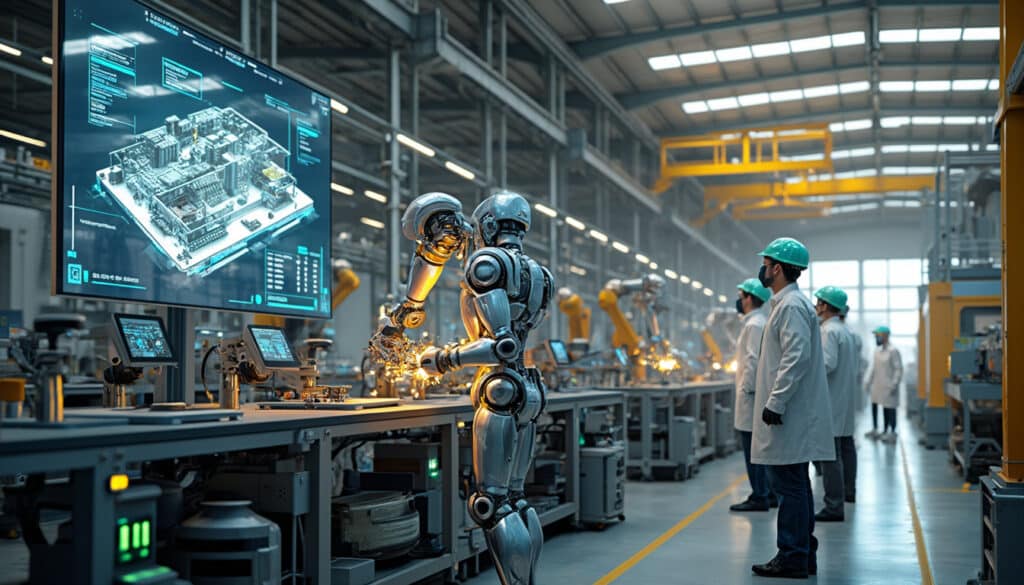Digital capabilities and artificial intelligence are revolutionizing the product development lifecycle. In Europe, the rapid adoption of advancements in digital engineering surpasses that of other regions. Industry 4.0 initiatives are transforming workplaces and creating personalized experiences for end users.
With the rise of digitalization, European companies are increasingly integrating generative AI (GenAI) capabilities into their product development processes. These technologies enable the automation of design, the creation of hyper-personalized customer experiences, and the generation of synthetic data for testing and optimization of models. Service providers play a key role in helping companies build extended teams and design comprehensive solutions, from product conceptualization to prototyping. Matteo Gallina, head of digital engineering solutions at ISG, emphasizes that this shift towards agentic AI can transform industrial operations by improving operational efficiency and streamlining production processes. Furthermore, technologies such as digital twins and digital threads provide real-time insights and complete traceability of product data. Model-based systems engineering (MBSE) is also becoming essential for designing complex, smart, and well-connected products, particularly in the automotive and manufacturing industries where Europe positions itself as a major geographic hub. Finally, development methods focused on a composable architecture allow for the creation of more flexible and adaptable systems while minimizing the carbon footprint.

Table des matières
ToggleWhat are the main drivers of GenAI adoption in European manufacturing?
The mainstreaming of generative artificial intelligence (GenAI) in European manufacturing is driven by several key factors that radically transform engineering and production flow management. According to the ISG Provider Lens™ study, Europe stands out for its rapid adoption of advancements in digital engineering, surpassing other regions in implementing Industry 4.0 initiatives. This momentum is fueled by a convergence between technological experimentation and practical execution, allowing companies to move from exploratory phases to large-scale deployments.
A crucial driver is the willingness to modernize the entire product development lifecycle. GenAI enables the automation of design, offering hyper-personalized customer experiences and creating synthetic data for testing and optimization of models. These capabilities not only improve operational efficiency but also reduce time-to-market for new products. Additionally, European companies benefit from the support of service providers who help build extended teams and design comprehensive solutions covering all stages from conceptualization to prototyping.
Moreover, the adoption of GenAI is bolstered by the integration of complementary technologies such as digital twins and digital threads. Digital twins provide virtual replicas of industrial assets, offering real-time operational insights and facilitating predictive maintenance. Digital threads ensure end-to-end traceability of product data within the organization, thereby improving transparency and lifecycle management of products.
Finally, competitive pressure and growing expectations from end users drive European companies to adopt innovative solutions to remain competitive. The ability of GenAI to transform industrial operations by enabling more automated decision-making and optimizing production processes is a major asset to meet these challenges and stimulate growth.
How is GenAI transforming the product development lifecycle?
The integration of GenAI into the product development lifecycle revolutionizes how companies conceive, develop, and launch new products. According to the ISG Provider Lens™ report, GenAI enables advanced automation of design, thereby reducing the time and resources required to move from the initial idea to a functional prototype. This automation extends not only to the design phase but also to simulation, analysis, and optimization of products, ensuring enhanced quality and performance.
One of the most impactful aspects of GenAI is its ability to generate synthesized data. This data allows for testing and optimizing design models without the need for large sets of real-world data, which are often costly and difficult to obtain. By using synthetic data, companies can accelerate the validation process for designs, quickly identify potential flaws, and make iterative improvements with increased precision.
Additionally, GenAI facilitates product customization by generating designs that are tailored to the specific requirements of each client. This hyper-personalization is essential in a context where consumers demand increasingly unique products adapted to their individual needs. By combining the capabilities of GenAI with the principles of Industry 4.0, companies can not only meet these expectations but also anticipate market trends and adjust their development strategies accordingly.
Furthermore, GenAI optimizes collaboration among the various teams involved in product development. Through intelligent tools and integrated platforms, engineers, designers, and project managers can work together more harmoniously and efficiently, easily sharing relevant information and insights. This interdisciplinary synergy fosters innovation and allows technical and logistical obstacles that could otherwise slow down the development process to be overcome more quickly.
What are the benefits of GenAI for personalizing customer experiences?
The GenAI offers unprecedented opportunities for personalizing customer experiences, a crucial factor in the European manufacturing sector. It allows for the creation of tailor-made experiences that precisely meet the expectations and individual needs of customers, thereby enhancing their satisfaction and loyalty. The ISG Provider Lens™ study highlights that GenAI not only enables the generation of personalized designs but also anticipates customer preferences through advanced analysis of behavioral data.
With GenAI, companies can analyze massive volumes of customer data in real time, identifying patterns and trends that would otherwise be undetectable. This analysis allows for the creation of detailed customer profiles and the development of specific offers that perfectly meet the expectations of each market segment. For example, in the automotive industry, GenAI can be used to design vehicles with features tailored to the specific preferences of different consumer groups, thereby providing a richer and more engaging user experience.
Another significant advantage is GenAI’s ability to generate personalized outcomes. This means that each customer interaction can be adjusted based on individual preferences, offering recommendations, services, and products that perfectly match their needs. This increased personalization extends not only to the products themselves but also to after-sales services, where companies can use GenAI to anticipate maintenance needs and provide proactive solutions, thus enhancing overall customer satisfaction.
Moreover, GenAI facilitates the establishment of targeted marketing strategies that are more effective. By gaining a better understanding of customer behaviors and preferences, companies can customize their marketing campaigns to reach the right market segments with the right messages, thereby maximizing the impact and return on investment of their advertising efforts.
Finally, personalizing customer experiences through GenAI helps strengthen the relationship between the company and the customer, creating added value that goes beyond a simple commercial transaction. By offering unique and tailored experiences, companies can differentiate themselves from their competitors and build a brand reputation centered around the customer, which is essential for long-term loyalty.
What roles do service providers play in the adoption of GenAI?
Service providers play a crucial role in the integration and adoption of GenAI within European manufacturing companies. According to the ISG Provider Lens™ report, these providers help companies overcome the technical and organizational challenges associated with implementing advanced technologies, providing comprehensive and customized solutions that cover the entire product lifecycle.
One of the primary roles of service providers is to create extended teams that can collaborate effectively with the internal departments of companies. This collaboration enables the design and development of custom solutions, from conceptualization and design to development and prototyping. By providing specialized expertise and additional resources, providers facilitate the rapid and effective adoption of GenAI, thus reducing the time required to move from idea to realization.
Additionally, service providers are often at the forefront of technological innovation, allowing them to offer solutions based on the latest advancements in GenAI and digital engineering. They can integrate technologies such as digital twins, digital threads, and advanced data management systems into manufacturing processes, thereby improving operational efficiency and product quality.
Moreover, service providers play a key role in training and skill development within companies. They offer training and support programs that enable employees to master new technologies and adopt innovative work practices. This ongoing training is essential to ensure that internal teams can fully leverage the capabilities offered by GenAI and maintain enhanced competitiveness in the market.
Finally, service providers help companies navigate the regulatory and environmental complexities associated with adopting new technologies. They provide strategic advice to ensure compliance with industry standards and local regulations while integrating sustainable and environmentally friendly practices into development and production processes.
What are the main challenges faced by European companies in adopting GenAI?
The adoption of GenAI in European manufacturing is not without challenges. Several obstacles hinder the full integration of these advanced technologies, despite the many benefits they offer. The ISG Provider Lens™ study identifies several major challenges that companies must face to successfully achieve their digital transition.
First, technological complexity constitutes a significant barrier. Integrating GenAI into existing systems requires specialized technical expertise and a deep understanding of industrial processes. Many companies must invest in training and skill development for their personnel to take full advantage of GenAI’s capabilities, which represents a significant investment in time and resources.
Next, managing data is a crucial challenge. GenAI relies on access to massive volumes of accurate and high-quality data. However, the collection, storage, and analysis of this data raise issues of security, privacy, and data management. Companies must establish robust infrastructures to ensure that data is protected and used effectively while adhering to current regulations, such as GDPR.
Another major challenge is related to the integration of emerging technologies with legacy systems. Many European companies still utilize outdated infrastructures that are not compatible with new technologies based on GenAI. Modernizing these systems is often costly and complex, requiring careful planning and significant investment to avoid production disruptions.
Furthermore, resistance to change within organizations can hinder the adoption of GenAI. Employees may be reluctant to embrace new technologies for fear of seeing their roles evolve or diminish. It is essential for companies to foster a culture of innovation and engagement, where employees are encouraged to adopt new approaches and collaborate with technical teams to maximize the benefits of GenAI.
Finally, economic considerations represent a non-negligible challenge. Adopting GenAI requires significant upfront investments in both technology and training. Companies must carefully evaluate potential returns on investment and plan their budgets accordingly to ensure a financially viable transition to advanced digital technologies.
How do complementary technologies enhance the impact of GenAI?
GenAI does not operate in isolation; it is often combined with other emerging technologies to maximize its impact in industrial engineering. The ISG Provider Lens™ study emphasizes that the integration of complementary technologies such as digital twins, digital threads, and model-based systems engineering (MBSE) enhances the efficiency and capabilities of solutions based on GenAI.
Digital twins are virtual replicas of a company’s physical assets that enable real-time simulation and predictive analysis. By combining GenAI with digital twins, companies can obtain in-depth operational insights, optimize production processes, and anticipate maintenance needs before they become critical. This synergy not only improves equipment performance but also the quality of final products, reducing defects and downtime.
Digital threads ensure complete traceability of data throughout the product lifecycle. When GenAI is integrated with digital threads, it can analyze this data more effectively, providing valuable insights for strategic decision-making. This allows for more transparent and efficient management of processes, facilitating coordination among the various teams and departments within the company.
Model-based systems engineering (MBSE) is an approach that integrates various engineering disciplines to design complex products in a coherent and integrated manner. By using MBSE in conjunction with GenAI, companies can design intelligent, well-connected, and optimally integrated products. This approach is particularly beneficial for industries such as automotive and manufacturing, where complexity and system integration are high.
Moreover, using composable architecture allows for the creation of modular and adaptable systems, thus reducing resource consumption and increasing flexibility in responding to market changes. This architecture facilitates the integration of GenAI by enabling rapid adaptation of systems to new requirements and technologies, thereby ensuring increased scalability and resilience.
By combining these technologies, European companies can create robust technological ecosystems that not only fully leverage the capabilities of GenAI but also amplify them in synergy with other innovations. This leads to a more holistic digital transformation and enhanced competitiveness in the global market.
Who are the market leaders in GenAI in Europe according to the ISG study?
The ISG Provider Lens™ Digital Engineering Services for Europe identifies several leaders in the field of GenAI and digital engineering services. These companies stand out for their ability to deliver comprehensive and innovative solutions across various quadrants, ranging from product design and development to smart operations and platform services.
Among the recognized leaders, Accenture, Capgemini, Cognizant, HCLTech, Infosys, TCS, and Wipro distinguish themselves as leaders in four quadrants each. These companies are renowned for their deep expertise in GenAI, their ability to provide tailored solutions, and their commitment to supporting companies in their digital transformation.
Other notable players such as HARMAN Tech Services, NTT DATA, and Tech Mahindra are also recognized as leaders in three quadrants each. Their specialization in specific areas of digital engineering allows them to provide highly specialized and superior services, thus meeting the diverse needs of European companies.
Furthermore, companies such as Akkodis, Cyient, LTIMindtree, LTTS, and Persistent Systems are identified as leaders in two quadrants each, demonstrating strong capacity for innovation and offering diverse solutions in the field of GenAI. These companies are also recognized as Rising Stars, with a promising portfolio and high growth potential, reflecting their dynamism and ability to quickly adapt to market changes.
Finally, GlobalLogic is mentioned as a leader in one quadrant, highlighting its specific expertise and role in the global GenAI ecosystem. The recognition of GlobalLogic and other leaders in the study reinforces the importance of choosing the right technology partner to successfully achieve digital transformation and fully leverage the benefits offered by GenAI.
What are the environmental benefits of adopting GenAI according to the ISG study?
The adoption of GenAI in the European manufacturing sector does not only lead to operational and economic improvements; it also brings significant environmental benefits. The ISG Provider Lens™ study highlights several trends in which GenAI contributes to more sustainable and environmentally friendly manufacturing.
One of the main advantages is the improvement of energy efficiency and the reduction of carbon emissions. By automating design and production processes, GenAI enables the optimization of resource use and minimizes waste. AI algorithms can analyze energy consumption in real time and identify opportunities for improvement, thereby allowing companies to reduce their carbon footprint and comply with increasingly strict environmental regulations.
Additionally, GenAI facilitates the development of more carbon-efficient production methods. Service providers employ innovative approaches to design software and systems that consume fewer energy resources throughout the product development lifecycle. Composable architecture, for instance, allows for the creation of modular and adaptable systems that require less new carbon consumption while providing significant flexibility to rapidly adapt to market changes.
Furthermore, GenAI contributes to predictive maintenance through digital twins, which help extend the lifespan of equipment and reduce the need for replacement and reconstruction. This proactive maintenance approach not only lowers costs but also reduces the environmental impacts associated with producing and disposing of faulty or obsolete equipment.
European companies are also adopting GenAI to optimize the supply chain by reducing inefficiencies and waste. By improving inventory management and predicting demand fluctuations more accurately, GenAI allows for minimal production excesses and unused resources, thereby contributing to a more sustainable use of materials and energy.
Finally, service providers’ commitment to developing more sustainable solutions reinforces the position of European companies as leaders in responsible manufacturing. By integrating eco-friendly practices into development and production processes, companies can not only meet consumer expectations for sustainability but also comply with global environmental standards, thereby ensuring sustainable economic growth that respects the environment.
What future developments are anticipated in GenAI for industrial engineering?
The future of GenAI in European industrial engineering looks promising, with many anticipated developments that will continue to transform the sector. The ISG Provider Lens™ study highlights several trends and innovations that are expected to shape the evolution of GenAI and its impact on manufacturing and engineering.
One key development is the ongoing advancement of machine learning algorithms and artificial intelligence. These algorithms are becoming increasingly sophisticated, enabling deeper data analysis and even more automated decision-making. This evolution allows companies to obtain more accurate insights and react more quickly to market changes and customer demands, thereby improving their agility and competitiveness.
Additionally, the integration of GenAI with emerging technologies such as augmented reality (AR) and virtual reality (VR) opens new possibilities for design and manufacturing. These technologies enable engineers to visualize and manipulate design concepts in an immersive way, thus facilitating the prototyping process and reducing costs associated with developing physical prototypes.
Another expected development is the expansion of the industrial Internet of Things (IoT), which, when combined with GenAI, will allow for even more granular data collection and heightened automation of production processes. This technological convergence will facilitate the creation of smart factories where machines and systems can communicate and interact autonomously, thereby optimizing overall efficiency and productivity.
Moreover, the shift towards open and collaborative platform architectures will facilitate the integration of GenAI into existing and future systems. These platforms will enable better interoperability between different technologies and providers, fostering smoother collaboration and continuous innovation.
Finally, the emphasis on sustainability and the circular economy will continue to guide the development of GenAI. Future innovations will focus on enhancing energy efficiency, reducing waste, and maximizing material reuse, thus aligning industrial growth with global environmental goals.
What are the key success factors for effective GenAI adoption?
For an effective adoption of GenAI to succeed in the European manufacturing sector, several key factors must be considered. These factors, identified by the ISG Provider Lens™ study, are essential to ensure that companies fully leverage the benefits offered by GenAI while overcoming the challenges associated with its integration.
First, a clear and defined strategy is essential. Companies must develop a precise roadmap that outlines the goals to be achieved, the technologies to be adopted, and the steps necessary to integrate GenAI into their operational processes. This strategy must align with the company’s overall objectives and be embedded in the organizational culture to ensure buy-in and commitment at all levels.
Next, investment in skills and training is crucial. GenAI requires specific competencies in data, programming, and technology project management. Companies must invest in ongoing training for their employees and, if necessary, recruit specialized talent to fill skill gaps. A well-trained workforce is essential to maximize the use of GenAI tools and ensure their operational efficiency.
Another success factor is the quality of the data. GenAI relies on accurate, complete, and well-structured data. Companies must implement robust data management systems to collect, store, and analyze information effectively. Good data governance ensures not only the reliability of analytics but also compliance with data protection regulations.
Moreover, collaboration with competent service providers is essential. These partners provide technical expertise, additional resources, and customized solutions that facilitate the integration of GenAI. Working with experienced service providers allows companies to benefit from best practices and the latest technological innovations, thereby accelerating their digital transformation.
Finally, adopting an iterative and agile approach can greatly contribute to the success of integrating GenAI. By implementing pilot projects and gradually adjusting strategies based on feedback, companies can minimize risks and optimize results. This flexibility allows for the rapid adaptation of solutions to evolving needs and emerging challenges, thus ensuring a sustainable and effective adoption of GenAI.
By bringing together these factors, European companies can create an environment conducive to innovation and digital transformation, thereby ensuring successful GenAI adoption and enhanced competitiveness in the global market.
[#Article] 🤖 Adoption de la GenAI : La Chine approuve 190 LLMs, renforce la gouvernance de l’IA générative et du cyberespacehttps://t.co/XFk8gv8uCr #IA #IntelligenceArtificielle
— Actu IA – Intelligence Artificielle (@ActuIAFr) August 20, 2024





